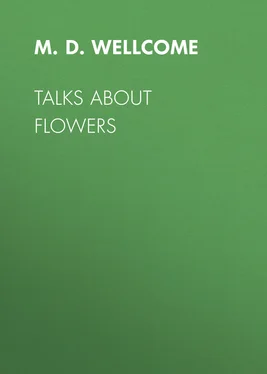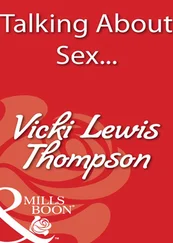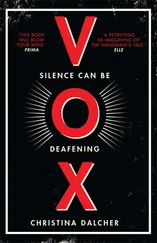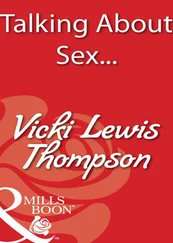M. D. Wellcome - Talks About Flowers
Здесь есть возможность читать онлайн «M. D. Wellcome - Talks About Flowers» — ознакомительный отрывок электронной книги совершенно бесплатно, а после прочтения отрывка купить полную версию. В некоторых случаях можно слушать аудио, скачать через торрент в формате fb2 и присутствует краткое содержание. Жанр: foreign_antique, Биология, Биология, foreign_edu, на английском языке. Описание произведения, (предисловие) а так же отзывы посетителей доступны на портале библиотеки ЛибКат.
- Название:Talks About Flowers
- Автор:
- Жанр:
- Год:неизвестен
- ISBN:нет данных
- Рейтинг книги:4 / 5. Голосов: 1
-
Избранное:Добавить в избранное
- Отзывы:
-
Ваша оценка:
- 80
- 1
- 2
- 3
- 4
- 5
Talks About Flowers: краткое содержание, описание и аннотация
Предлагаем к чтению аннотацию, описание, краткое содержание или предисловие (зависит от того, что написал сам автор книги «Talks About Flowers»). Если вы не нашли необходимую информацию о книге — напишите в комментариях, мы постараемся отыскать её.
Talks About Flowers — читать онлайн ознакомительный отрывок
Ниже представлен текст книги, разбитый по страницам. Система сохранения места последней прочитанной страницы, позволяет с удобством читать онлайн бесплатно книгу «Talks About Flowers», без необходимости каждый раз заново искать на чём Вы остановились. Поставьте закладку, и сможете в любой момент перейти на страницу, на которой закончили чтение.
Интервал:
Закладка:
However, for the benefit of those who prefer to sow their own seed, we will give directions for the best method. First, be sure that the seed is new. Don't sow old seed for it will not germinate. If you have no hot bed, make one in a box or pan by putting in a layer of quite fresh horse manure for bottom heat; over this a layer of coarse sand; then fill the box with finely sifted soil, mixed with at least one-third fine sand. Make it smooth; then in little rows drop the seeds, not very sparsely, for all may not germinate, and if too thick when they come up they can be thinned out. Press the seed down with a bit of flat board, sift a little soil over them and then dampen by light spraying with tepid water; a brush dipped in water makes a gentle sprayer. Cover with paper, glass, or what is better, a bit of soft flannel wrung out of water laid on the surface, as it keeps the soil damp without sprinkling, by being wet as it dries. The soil must be kept moist, not soaking wet, for however helpful to germination a previous soaking may be, when sown the seed must not be drenched, and the same rules are equally applicable to the seedlings, for in either case rot would surely follow. It is just here where the special care is requisite to insure success. After the plants have come up, the flannel or paper must be removed and the seedlings given sunshine and air, though it is well to have a glass over the top of the box for a week or more, as more moisture is thereby secured; but there ought to be an aperture for the admission of air. When two or more leaves are developed, it is well to prick them out into other boxes or pots, if they are too thick for free growth; not all, a part can remain undisturbed. They should be gradually hardened as a preparation for out-door life, by being placed in cool situations. While heat is essential to start the seed into growth, it is not beneficial to the plants, and those who have a cold frame had better remove the plants to it as soon as the temperature will admit.
In bedding out, an open situation is preferable. The ground should be well dug and enriched, with well-decomposed manure, and if the soil is heavy a liberal mixture of sand. A situation where the morning sun will not strike them before the dew is off in the morning is best, as this is one cause of the mildew or rust which so frequently saps the vitality of the leaves. In order to promote their spreading, it is a good plan to fasten down some of the branches when sufficiently flexible to the ground, and for this, nothing is more convenient than hair-pins. All the seed vessels should be pricked off in order to secure the best results, as much of the strength of the plant goes to them if allowed to remain. One can afford to be very liberal in gathering the flowers, for the more liberally they are picked off, the more rapidly buds form and develop. As it was with one of Bunyan's characters:
"There was a man (though some did count him mad),
The more he cast away, the more he had."
The wise man says: "There is that scattereth and yet increaseth."
A florist says that "to grow Verbenas successfully, plant them in beds cut in the turf. Chop the turf well and thoroughly mix with it a good share of well-decomposed stable manure; never, on any account plant them in old and worn-out garden soil as they will most assuredly fail. Give them a change of soil each season, as they do not thrive well two years in the same bed."
As a house plant the Verbena is not a success. It is most always sickly, and infested with red spiders. They cannot be kept over winter in a cellar; it is growth or death.
Verbenas were first introduced into Europe about fifty years ago from South America, and a few years later into this country. They have been greatly improved, and the varieties are very numerous. Many are fragrant. The only hardy sort is Montana, a native of Colorado. It is a profuse bloomer, color, a bright rose. There are the German Hybrids, the Italian stripes, and the Drummondii from Texas. Every year brings its novelties, as with other flowers. Mr. C. E. Allen, who makes a specialty of seedling Verbenas, is sending out several fine ones this season; Silver Queen, Florence, Emma, Carroll, Ralph and Variegata are very attractive according to the descriptions.
PETUNIAS
Few things in the garden will make more show throughout the entire season, even after quite severe frosts, than a bed of Petunias from a paper of seed marked "Choicest Mixed from Show Flowers." They will produce such a profusion of flowers, charming one from day to day with their variations of markings, and of color. Some retain their distinctive characteristics, while with others they are changeful as the Kaleidoscope. Stripes, blotches, sprays, white throats, green edges, they are just lovely. Then there are the double sorts; purple with white spots, white with purple; rose color, white, purplish-crimson margined with white; lilac veined with purple; white with stripes of purple in the center of each petal, some exquisitely fringed; large and full as a rose, and some almost as sweet.
In nothing, perhaps, has there been such a wonderful improvement by culture and hybridising as the Petunia. Mr. Vick tells us how that half a century ago, he saw for the first time, a Petunia. It was a novelty—a strange flower from a flowery land, South America, and it was carefully treated in green-houses. The flower was white and small, and looked somewhat as if made of paper—such a flower as would now be destroyed if by chance seen growing accidentally in our gardens. The novelty soon subsided, and although it was ascertained that it could be grown in gardens, it did not possess sufficient merit to gain popular favor. A little later, however, about 1831, to the astonishment of the floral world, it was announced that a new Petunia, of a purple color, had been discovered in Buenos Ayres. It was first flowered and seeded in the Botanic Gardens of Glasgow, and thence seed was sent all over Europe and to America, where it soon became a great favorite. About thirty years ago a double Petunia was grown and propagated by cuttings. It was only semi-double and white, but it was the commencement of a new era in Petunia culture. Truly wonderful have been the advances in development of this beautiful flower.
The Petunia is divided into three distinct classes, the Grandiflora, Small Flowered and Double.
The Grandiflora varieties have a strong succulent growth, the flowers are not so numerous as some others, but are very large and double, frequently measuring three inches in diameter, and some kinds are exquisitely marked with various shades of violet, purple, maroon and scarlet upon white ground; some striped, others bordered, some marbled, some deeply fringed. The double Petunia gives no seed, and it is only by fertilizing single flowers with the pollen of the double that seed can be obtained. But Petunias of all kinds are easily multiplied by cuttings.
The Small Flowered class are those that make our gardens so attractive with their varied hues and markings. Some of the new hybrids are of wonderful beauty. Last year gave two of the Double and Fringed sort that have been frequently noted as gems of the first water.
Mrs. Edward Roby, color, a glowing crimson-maroon, edged with pure white, very double and deeply fringed. Model of Perfection, deep maroon, heavily edged with white, and deeply fringed. These were priced last year in a Western catalogue at $1.50 each; this year they are priced at 30 cents. So one gains by waiting a year for high-priced novelties.
New Double Fringed Petunia for 1881, is President Garfield, which originated with Mr. C. E. Allen, and is thus described in his catalogue: "Color, light purple veined with deep purple magenta, edged with a broad band of an exquisite shade of green. Very novel in its appearance and a new color in double petunias; flower very large and deeply fringed. Plants strong and vigorous; one of the finest sorts ever offered." For a Petunia so unique as this, with its broad band of green, and now offered for the first time; its price, 75 cents, is low.
Читать дальшеИнтервал:
Закладка:
Похожие книги на «Talks About Flowers»
Представляем Вашему вниманию похожие книги на «Talks About Flowers» списком для выбора. Мы отобрали схожую по названию и смыслу литературу в надежде предоставить читателям больше вариантов отыскать новые, интересные, ещё непрочитанные произведения.
Обсуждение, отзывы о книге «Talks About Flowers» и просто собственные мнения читателей. Оставьте ваши комментарии, напишите, что Вы думаете о произведении, его смысле или главных героях. Укажите что конкретно понравилось, а что нет, и почему Вы так считаете.












